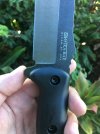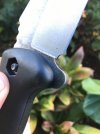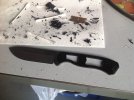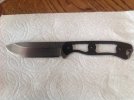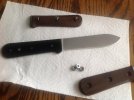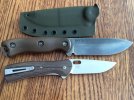-
The BladeForums.com 2024 Traditional Knife is ready to order! See this thread for details: https://www.bladeforums.com/threads/bladeforums-2024-traditional-knife.2003187/
Price is$300$250 ea (shipped within CONUS). If you live outside the US, I will contact you after your order for extra shipping charges.
Order here: https://www.bladeforums.com/help/2024-traditional/ - Order as many as you like, we have plenty.
You are using an out of date browser. It may not display this or other websites correctly.
You should upgrade or use an alternative browser.
You should upgrade or use an alternative browser.
Protecting a stripped knife BK16
- Thread starter chuck4570
- Start date
- Joined
- Oct 18, 2018
- Messages
- 7,815
You are probably going to get a variety of answers....i just received a BK16 and I would like to strip and patina it. My question is the patient under the scales enough to protect from rust or should this area be protected with something. If it should be protected what does everyone use.
Chuck
*Leave the area under the scales painted. (I did this for a year with my BK-5, but just recently did a complete strip. I hated the way that looked.
The Becker's just look so much better without paint. (my opinion)
*Strip it, and patina it ( my BK-9 isn't showing any issues This way)
*Lacquer it
*Oil it. (I'm currently coating the inside of my one BK-62 with Vaseline)
*Don't worry about it....maybe occasionally take the scales off and buff the rust spots off. (the scales are made to come off, for a reason)
You might just try it out, and see what works for you.
eveled
Gold Member
- Joined
- Mar 11, 2016
- Messages
- 7,996
Patina the whole blade. Oil the whole blade. Put it together and use it.
If it gets wet. When you put it away Remove from the sheath, remove scales, dry it oil it reassemble and repeat. That’s the necessary maintenance with a steel blade. As Crag said the scales come off for a reason.
If it gets wet. When you put it away Remove from the sheath, remove scales, dry it oil it reassemble and repeat. That’s the necessary maintenance with a steel blade. As Crag said the scales come off for a reason.
I would concur with Eveled, complete strip and patina.
Although I have not done a Becker, I have done many other brands.
I find the patina helps to delay heavy oxidation, and I have been happy with keeping it regular rubbed down with Ballistol, mineral oil or one of the carnauba based waxes.
Although I have not done a Becker, I have done many other brands.
I find the patina helps to delay heavy oxidation, and I have been happy with keeping it regular rubbed down with Ballistol, mineral oil or one of the carnauba based waxes.
- Joined
- Oct 18, 2018
- Messages
- 7,815
Thanks all for the advice, I think I will strip the whole knife and patina. What is a good forced patina method, or just let it patina with use and age.
azwelke really nice kydex you do, I will be looking in to these.
Chuck
Depends if you want it plain, or lots of pattern?
I like vinegar soaks for a flatter dark look.
and mustard glopped on for a pattern.... Only your creativity limits you!
*Both styles will get rubbed off if under heavy use.... like battening something crazy....hahaha
but then you can just reapply
- Joined
- Sep 13, 2017
- Messages
- 9,095
I stripped my 10 with the scales on and it kept the coating on under the scales. This way the portion under the handle scales stays protected but the rest of the knife is uncoated.
- Joined
- Sep 13, 2017
- Messages
- 9,095
- Joined
- Dec 16, 2013
- Messages
- 194
I just did my 10 and 11. Stripped them all the way down, and patinad with mustard. Taped up the blade side , attached scales removed tape around scales, removed scales, Got some Rust-Oleum Automotive clear coat spray paint, and sprayed a couple of coats over the handle sides. Came out perfect, and the Rust- oleum prevents the rust. I'll still check occasionally to see if there are any issues. Rubbed mineral oil on the blade.
https://bladeforums.com/threads/bec...ication-thread.1224943/page-112#post-18856410
https://bladeforums.com/threads/bec...ication-thread.1224943/page-112#post-18856410
Last edited:
- Joined
- Feb 11, 2011
- Messages
- 845
1. Handles off
2. Degrease the whole knife
3. Use anything acidic on it (lots of things work - Lemon Juice, strong Instant Coffee, etc.) and let sit for a bit until you see it darkening or it dries
4. Wash off with water and a rag
5. This is when I use Scotchbrite on the Grind area, rubbing in a spine to edge direction to polish off the etching from the acid
6. Wipe clean and re-apply etching solution and leave to darken/dry
7. Wash off with a rag and water
8. Scotchbrite the blade grind portion, again, and then spray it all with Windex to neutralize the acid.
9. Rinse, dry, and rub it down with a little oil.
The smoother the surface, the less pits/grooves there are for corrosion to start.
Smooth or polished 1095 just won't rust that easily. Trust me
** Wiping acidic stuff off of your blade after contact prevents pitting. That includes Sweat, Beer, Alien Blood, etc.
Have fun and re-etch your blade once in a while!
2. Degrease the whole knife
3. Use anything acidic on it (lots of things work - Lemon Juice, strong Instant Coffee, etc.) and let sit for a bit until you see it darkening or it dries
4. Wash off with water and a rag
5. This is when I use Scotchbrite on the Grind area, rubbing in a spine to edge direction to polish off the etching from the acid
6. Wipe clean and re-apply etching solution and leave to darken/dry
7. Wash off with a rag and water
8. Scotchbrite the blade grind portion, again, and then spray it all with Windex to neutralize the acid.
9. Rinse, dry, and rub it down with a little oil.
The smoother the surface, the less pits/grooves there are for corrosion to start.
Smooth or polished 1095 just won't rust that easily. Trust me
** Wiping acidic stuff off of your blade after contact prevents pitting. That includes Sweat, Beer, Alien Blood, etc.
Have fun and re-etch your blade once in a while!
- Joined
- Aug 21, 2010
- Messages
- 1,475
Followed you link, that’s a nice looking 10 & 11 you got there.I just did my 10 and 11. Stripped them all the way down, and patinad with mustard. Taped up the blade side , attached scales removed tape around scales, removed scales, Got some Rust-Oleum Automotive clear coat spray paint, and sprayed a couple of coats over the handle sides. Came out perfect, and the Rust- oleum prevents the rust. I'll still check occasionally to see if there are any issues. Rubbed mineral oil on the blade.
https://bladeforums.com/threads/bec...ication-thread.1224943/page-112#post-18856410
- Joined
- Aug 21, 2010
- Messages
- 1,475
I’ll have to look for examples of scotch brighter grind areas, that sounds like a nice contrast.1. Handles off
2. Degrease the whole knife
3. Use anything acidic on it (lots of things work - Lemon Juice, strong Instant Coffee, etc.) and let sit for a bit until you see it darkening or it dries
4. Wash off with water and a rag
5. This is when I use Scotchbrite on the Grind area, rubbing in a spine to edge direction to polish off the etching from the acid
6. Wipe clean and re-apply etching solution and leave to darken/dry
7. Wash off with a rag and water
8. Scotchbrite the blade grind portion, again, and then spray it all with Windex to neutralize the acid.
9. Rinse, dry, and rub it down with a little oil.
The smoother the surface, the less pits/grooves there are for corrosion to start.
Smooth or polished 1095 just won't rust that easily. Trust me
** Wiping acidic stuff off of your blade after contact prevents pitting. That includes Sweat, Beer, Alien Blood, etc.
Have fun and re-etch your blade once in a while!
- Joined
- Dec 16, 2013
- Messages
- 194
Followed you link, that’s a nice looking 10 & 11 you got there.
Thanks, I think it came out pretty well for a first timer.
- Joined
- Nov 15, 2018
- Messages
- 198
I use Circa 1856 furniture stripper to remove powder coats. Glob that on and it bubbles off in a few minutes. Wipe clean, steel wool on any stubborn spots. Clean with acetone.
There's tons of different ways to patina. My go to is to soak paper towel in vinegar, grind up some rock salt onto the paper towel, then wrap the blade in it and stick it in a Ziploc for 15-30 minutes. Wash then neutralize with baking soda. I've had good results with mustard, potatoes, grapefruit, red onions...
I also like using muriatic/hydrochloric acid and copper sulphate:



You can also use nail polish as a resist and create cool patterns or lettering and such, and after the etch, clean it off with acetone.

Have fun with science!
There's tons of different ways to patina. My go to is to soak paper towel in vinegar, grind up some rock salt onto the paper towel, then wrap the blade in it and stick it in a Ziploc for 15-30 minutes. Wash then neutralize with baking soda. I've had good results with mustard, potatoes, grapefruit, red onions...
I also like using muriatic/hydrochloric acid and copper sulphate:



You can also use nail polish as a resist and create cool patterns or lettering and such, and after the etch, clean it off with acetone.

Have fun with science!

